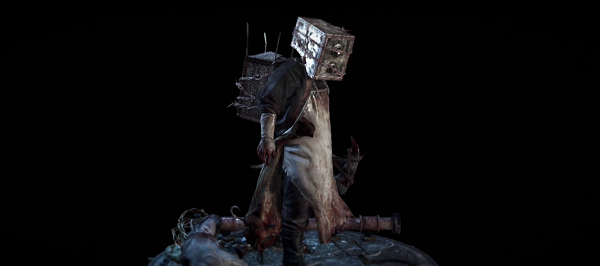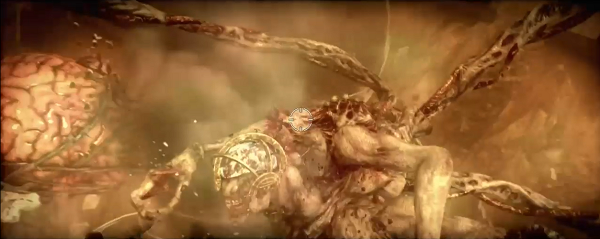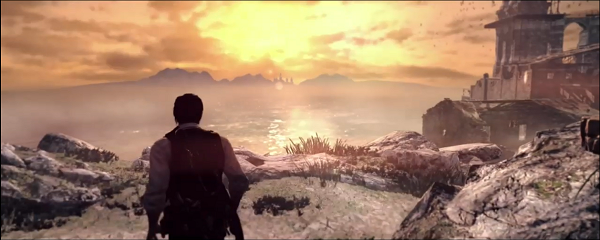
[Disclaimer: I have never played more than 20 minutes of Resident Evil 4, so some elements of The Evil Within that might seem familiar to others are not so for me.]
I love horror movies. I am a big fan of all genres but my fondness for 70s and 80s schlock is pretty substantial. I love the schadenfreude in watching the jock/nerd/cheerleader/stereotype go down to the basement or into an inexplicably dark alleyway, heading toward a gory demise whilst I am shouting “Don’t go there!†(This is, incidentally, a lie: the only time I actually shout at the television is during marathon sessions of Gossip Girl on Netflix.)
The thing about these horror films is that you, the watcher, would never stick your head into these cubbyholes of death. You wouldn’t even be in the same post code.
In The Evil Within you don’t just stick your head into these cubbyholes: you do it willingly in the hope that something good will come of it.
The justification for this apparently survival-averse approach is simple: pretty much everything wants to kill you and you never have enough with which to defend yourself.
You play the part of Sebastian Castellenos, a police detective who has been sent to a hospital to… I don’t know. Like any good/bad horror film this game’s story line involves Mindjack levels of nonsensical bullshit, existing merely to provide opportunities to relax and watch something dumb, sort of like the comedy relief character in horror films who you know is going to live through the entire thing through sheer luck. That said, having seen all of the fucking ridiculousness The Evil Within has to offer, it only serves to make the gruesome gameplay all the more disconcerting.
The very first significant task the game gives you is taking on a chainsaw-wielding maniac, and the game immediately puts you in your place by introducing you to your murder at his hands. This is not canonical in terms of storyline but it is canonical to your future experience of the game. Castellenos will die. A lot.
A little time later you get a gun and the game shows you that it is going to take as many as three head shots to kill something – if you are lucky.
Shortly after that, and the final tutorial segments (that really don’t explain everything), the game becomes a series of ever-escalating set pieces punctuated by the best tension-building moments I have witnessed in recent years. The latest Wolfenstein understood how to introduce quiet moments to contrast its messier chaos; The Evil Within’s moments of quiet are often more excruciating than the ensuing terror. As a result it finds as many ways to torture you.

An early example of the game’s delight in terrorising you is that just before a new level – following one in which you spend ages skulking through the undergrowth surrounding a decaying village in which untold horrors await – the loading screen informs you that you’ll be able to spot invisible enemies by the splashes they make through water. Having only just mentally fortified myself to deal with traps, gurning nutcases and a psychopath with a chainsaw, reading that sentence made my heart sink. The next level consisted of me inching through every environment and hesitating every time I saw a patch of liquid. It was over an hour before I encountered one of these enemies but by the time I did I was so ramped up thanks to the constant false flags that this one creature ended up ‘being an event’ unto itself.
I then walked around a corner to find an entire flooded washroom and my heart absolutely dropped.
Much of the fear that the game manages to conjure is based around bullets: during your first playthrough you will never feel like you have enough of them and even when you have an abundant supply it will only serve to make you uneasy about what is coming next. More bullets, after all, probably means nastier enemies. As a result, you find yourself trying to make sure that you are prepared for what is to come by walking into, say, that room with the flickering overhead neon light, hoping that inside there will be some more bolts for your crossbow. You will follow that corridor off the main path, the one with the creepy noises emanating from it, and you will do it because you have to: you need what might be found there.
A lot of criticism that I have seen levelled at the game concerns the erratic nature of its rhythms. One level will be an extended boss encounter whilst another will have two sporadic fights with a boss, another still will have three encounters (in some of which the boss is invincible) and others still involve no fights with bigger enemies at all. I don’t see a grounding in this criticism at all; the uneven nature of the levels means that you really don’t know what is going to happen next.
The fact that The Evil Within manages to continue to change up its style of play and keep the player guessing – in one case by completely confounding you and going fully into Gears of War mode – is astounding. One moment you’re given tons of ammunition to psychologically prepare you for an encounter that never comes; in another you are provided with a fixed turret and in order to conserve bullets you have to lure enemies into its line of fire. The game is brilliantly inventive.
I am not prone to replaying a lot of games as I find most tend to be a ‘once and done’ scenario, but Shinji Mikami (the director of The Evil Within and the phenomenal Vanquish) and his team dangle unlocks that completely change the game. If the first playthrough feels like you are the protagonist of a zombie apocalypse film in the vein of Dawn of the Dead the second playthrough makes you feel like Ash Williams in Army of Darkness. A co-worker of mine coined the term ‘revenge replay’ to describe this and it fits perfectly.

There are some shortcomings to the game. The artistic wide-screen approach looks great until you start to notice that it blocks out important context sensitive prompts. Some of the textures used look decidedly last gen and it can be distracting where some walls are just blurry messes.
That’s your lot though: this is the first proper horror survival game in years and it pushes every button that needs pushing. It develops spectacularly over the course of one run, and then manages to transform into something completely different by the second visit. It might just be one of the best games of 2014.
[Addendum: Since writing this review I’ve spoken to more people who have played both Resident Evil 4 and The Evil Within. The opening of The Evil Within is widely regarded as utterly terrible in contrast to RE4. In addition certain fans (whom I trust) of Resident Evil have generally found The Evil Within to be a poor homage to the zombie game franchise, although one such fan admitted that if Resident Evil 4 didn’t exist The Evil Within would be rather amazing. So: I stand by my review, but some stalwart fans of the survival horror genre will not find The Evil Within as invigorating as I did.]
Comments
4 responses to “Review: The Evil Within”
Your review does somewhat encourage me to give the game another try… but I think I'm going to pass. The demo turned me off so much with the utterly execrable forced stealth pattern memorisation section. I am rather partial to Mikami's work, but life is too short to persevere with something you hated*.
Who knows though, perhaps you'll manage to convince me when we come to our 2014 GOTY podcast!
* I finally watched The Legend of Chun-Li over Christmas. Thanks a fucking bundle, Mike.
Too bad, The Evil Within was the first time since Vanquish where I have felt the Mikami magic.
The problem with The Evil Within is that it won't demo well, so even if I did bring down the game you need to be exposed to it on your own or with someone who has never played it.
The problem with the game's demo is that it ruined my faith in the game.
Mikami-san let everyone down. What a dreadful experience.
Care to elucidate on that?